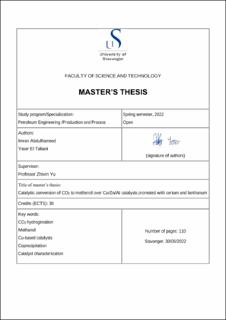| dc.description.abstract | Carbon dioxide is one of the most prominent greenhouse gases, and the rise in its emissions is
causing an increase in the world’s temperature, which can have catastrophic effects if it is not
controlled. Governments and organizations are working hard to implement sustainable
solutions to address the issue of climate change. Among proposed solutions, the capture of CO2
and its recycling to valuable fuels and chemicals has grabbed the attention of scientists. CO2
hydrogenation to methanol is a promising technological solution as methanol is an important
component in the fuel sector and carbon utilization is an environment friendly way to reduce
the emissions.
Heterogenous catalytic systems are applied to convert CO2 to methanol, and the commercial
catalyst, Cu/ZnO/Al2O3, is one of the most used catalysts because of its relatively high
performance and relatively low cost compared to other heterogenous catalyst. However,
promoters were added to this catalyst to improve its performance and make it effective for
industrial utilization of CO2 hydrogenation to methanol. Cerium and lanthanum precursors
showed good performance when added to the Cu/ZnO/Al2O3 catalyst when the catalyst is
prepared with the co-precipitation method. However, it was demonstrated that more promising
performance could be obtained when lanthanum was added to the conventional catalyst through
a sequential preparation method. In this study, two series of catalysts were prepared by the
coprecipitation method using different amounts of cerium and lanthanum as promoters. The
performance of the promoted catalysts was compared to a conventional Cu/ZnO/Al2O3 catalyst.
Furthermore, a La promoted catalyst was also prepared using a sequential preparation method
by impregnating the Cu/ZnO/Al2O3 catalyst with lanthanum. The catalysts were characterized
by XRD, TPR, TEM, N2 adsorption-desorption, and N2O chemisorption.
The catalytic performance of the catalysts was tested in a fixed bed reactor at 230°C, 40 bar,
and H2/CO2/N2 ratio of 3/1/1. The lanthanum promoted Cu/ZnO/Al2O3 catalyst prepared by the
sequential preparation method showed the highest methanol selectivity of 49.9% and space time
yield of 1357 mmol·gcat-1·h-1. For the catalyst prepared by co-precipitation, the catalysts
containing 2% cerium and 4% lanthanum showed the best catalytic performance. It was also
observed that the promoted catalysts showed superior performance at different reaction
conditions (temperature, pressures, and gas-hour space velocity) compared to the unpromoted
catalyst. Furthermore, long-term tests over 72 h indicate that the stability of the catalyst is
enhanced for the La and Ce promoted catalysts. | |
